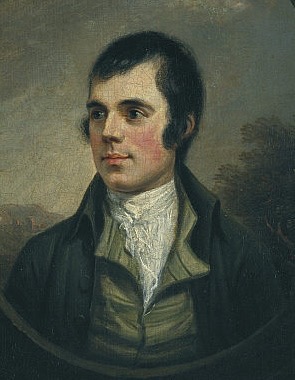
Robert Burns
Robert Burns, the great lyrical poet (1759-1796) was born in Scotland on the 25th January and as that date approaches, I must warn you, I become very Scottish.
Burns was a nationally recognized poet, even in his own lifetime. His poems were brilliant and funny insights into the human condition. Drawing on his own faults, and he freely admitted that especially where woman were concerned he had many, he painted a true picture of human weakness and foibles. However, he also celebrated the best of mankind, ‘A Mans a Man for all that’, citing the need for a universal coming together of all people to create a better world, was sung at the opening of the new Scottish Parliament. His words can also be found on the outside of the building.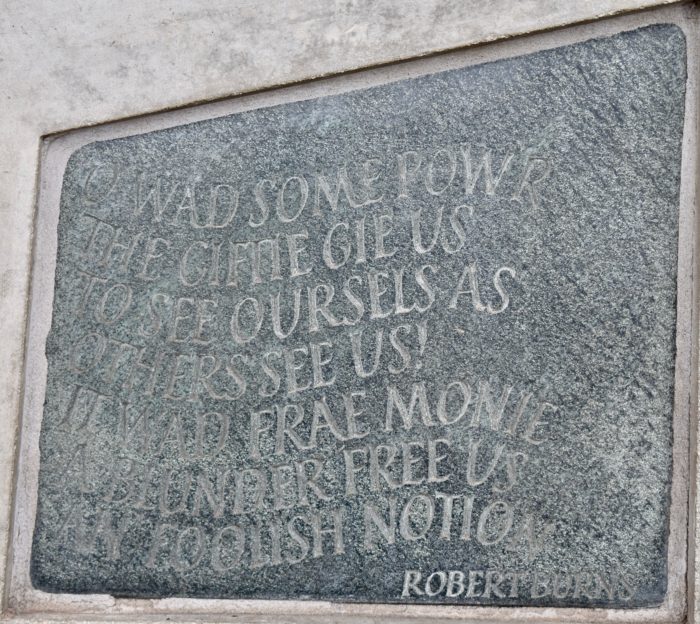
The love song ‘My love is like a red, red rose’ was chosen by Bob Dylan as the most influential song in Dylans’s career. Undoubtedly his most famous song, and one I am sure you have all sung many times, is ‘Auld Lang Syne’. We quote Burns whenever we say ‘Best laid plans’. It is a misquote however, as the full line is ‘Best laid schemes of mice and men gang aft agley,’ from his poem ‘To a Mouse’
Burns Nights
After his untimely death, friends started gathering on the anniversary of his birthday to read his poems and remember his life. The tradition spread and as Scots left Scotland and travelled the world, so did the Burns Nights.
I have attended a small Burns Supper with only six people (two of whom were English). When I worked at the Clydesdale Bank I also had the honor of attending the largest Burns Supper in the world, held in London, by the Institute of Bankers in Scotland. Burns Suppers may take many different forms, from a few friends gathering to eat haggis and drink whiskey to large formals dinners with full Scottish dress. There is a generally accepted running order and menu for these glorious events but each shares the same goal, to celebrate the life and works of our greatest national Bard.
What exactly is a Burns Night?
The evening consists of music and poetry by Robert Burns, traditional Scottish food, speeches and, if you come to our house, traditional Scottish dancing.
I think I am not alone in becoming more Scottish the further away I am from Scotland, which might account for the popularity of Burns Nights. One of the first things we did upon arriving in both Connecticut and Copenhagen was host a Burns Supper. We asked everyone to wear black tie, ‘Highland’ attire or at the very least sport a wee bit of tartan.
It is also more fun if you ask some of the guests to take part in the evening, so we allocate speeches and grace. Alan is the host and usually takes care of the Immortal Memory (see below), whilst my party piece is to address the haggis. This involves reciting a poem extolling the virtues of Scotland’s national dish, haggis.
Haggis
There are all sorts of entertaining stories written about haggis and how to catch them. About how a proper free range organic haggis, or a wild haggis newly caught is a real delicacy. Depending on the region of Scotland the legs vary in length, to allow the haggis (plural of haggis is haggis) to better run round hills. (Click on either of the links to read some charming rubbish.)
I hate to disillusion you but there is no such animal known as a haggis, and never has been. I can however give the recipe, passed from generation to generation.
Step 1. Buy a sheep
Step 2. Sell the wool
Step 3 Cook the rest!
The most famous haggis are sold by McSween of Edinburgh, and clicking on the link will bring you to their complete selection of products. I recently had a fabulous one from Coburns of Dingwell. In America it is impossible to buy a real haggis, all sorts of health and safety regulations. You can however buy a passable version from Camerons British Foods either directly ( as we used to at great expense as they airfreight it in frozen) or nip up to New Canaan in Connecticut to the British shop ‘Goldenberry’.
Traditional running order for a Burns Supper
When we held Burns Suppers In Connecticut we were delighted to find out that one of our friends, Jamie, could play the bagpipes. Whilst greeting friends with some traditional Scottish music is perfectly fine, having someone play the bagpipes as everyone arrives is truly spectacular.
Welcome by the Host or Master of Ceremonies
I think that is pretty self explanatory.
The Selkirk Grace
A short prayer is read before the haggis is brought in.
Some hae meat and canna eat,
And some wad eat that want it,
But we hae meat and we can eat,
And sae the Lord be thankit.
Piping in the Haggis
It is traditional for the haggis to be carried in on a silver platter, accompanied by more pipe music. It is accompanied by the person who will address the haggis, and a whisky bearer. The guests, who normally stand, clap in time with the music until the haggis reaches its destination. Then someone has to address the haggis, which means they read the following poem. During verse three they have to cut into the haggis, usually a dramatic moment as there is always the danger of the wee beastie exploding. Afterwards everyone has a dram as they toast the haggis and settle down after all the excitement.
Address to a Haggis
Fair fa’ your honest, sonsie face,
Great chieftain o the puddin’-race!
Aboon them a’ ye tak your place,
Painch, tripe, or thairm:
Weel are ye worthy o’ a grace
As lang’s my arm.
The groaning trencher there ye fill,
Your hurdies like a distant hill,
Your pin wad help to mend a mill
In time o need,
While thro your pores the dews distil
Like amber bead.
His knife see rustic Labour dight,
An cut you up wi ready slight,
Trenching your gushing entrails bright,
Like onie ditch;
And then, O what a glorious sight,
Warm-reekin, rich!
Then, horn for horn, they stretch an strive:
Deil tak the hindmost, on they drive,
Till a’ their weel-swall’d kytes belyve
Are bent like drums;
The auld Guidman, maist like to rive,
‘Bethankit’ hums.
Is there that owre his French ragout,
Or olio that wad staw a sow,
Or fricassee that wad mak her spew
Wi perfect scunner,
Looks down wi sneering, scornfu view
On sic a dinner?
Poor devil! see him owre his trash,
As feckless as a wither’d rash,
His spindle shank a guid whip-lash,
His nieve a nit;
Thro bloody flood or field to dash,
O how unfit!
But mark the Rustic, haggis-fed,
The trembling earth resounds his tread,
Clap in his walie nieve a blade,
He’ll make it whissle;
An legs an arms, an heads will sned,
Like taps o thrissle.
Ye Pow’rs, wha mak mankind your care,
And dish them out their bill o fare,
Auld Scotland wants nae skinking ware
That jaups in luggies:
But, if ye wish her gratefu prayer,
Gie her a Haggis
And then we eat.
Traditional Burns Night Menu
Cock-a-leekie soup (see below)
Haggis, neeps and tattles
(Haggis, mashed turnips or swedes and mashed potatoes)
Cranachan (see below)
You can vary the menu. I normally served Haggis, neeps and tatties as a starter and serve beef stew or salmon as a main course. My recent Haggis Beef Wellington would be also be an excellent choice. An alternative to cranachan would be sticky toffee pudding.
The Speeches.
At every Burns supper we have the same three speeches. The speakers are expected to reference Burns wherever possible.
The Immortal memory
The first speaker, male or female, tells us about the life of Robert Burns. He or she quotes Burns and reflects on his genius, politics and his human frailty. The speaker ends by giving the toast
“To the Immortal Memory of Robert Burns!”
Toast to the Lassies
One of the men is asked to make a toast to the lassies. The speech is meant to be humorous whilst making depreciating remarks about woman and their place and role in society. Towards the end there is usually a grudging acknowledgment that men would be lost without woman and quite possibly they are both the fairer and superior sex. It is lighthearted and the speech always finished with the Toast: “To the Lassies!”
Reply to the Toast to the Lassies
As is right and proper the ladies always get a chance to have the last word. This final speech of the night is a rebuttal to the toast to the lassies. The speaker usually laments the dreadful state of men, listing their all too numerous failings. Again, at the end, the speaker acknowledges that maybe the men are not too bad after all.
I had the honor of being asked to Reply to the Toast to the Lassies. I have printed the full speech below.
After all the speeches, everyone is usually ready to do a wee bit of dancing. In a private home we are usually a bit short of space. However we can usually manage an Eightsome Reel (or our version of it), a Strip the Willow and a Gay Gordons. With a wee bit more space I love the progressive Dashing White Sergeant.
At the end of the evening we ask everyone to form a circle, hold hands and sing ‘Auld Lang Syne’.
Beyond the traditional parts of the evening, you can certainly add extra entertainment. Should there be any good singers present they can be prevailed upon to sing one of Rabbie’s many songs. Quite often someone ‘finds’ an old lost poem by Burns, and recites a fictitious verse or two on a topical subject. Involving guests is a great way to have a successful Burns Night.
Just be warned that as January 25th approaches we Scots become rather nationalistic but fun to be with. Check if there is a Burns Night happening near you. We discovered we had missed one last year in an Irish pub in the centre of Copenhagen. We will not be making that mistake again!
Cock-a-leekie Soup
This was one of the recipes that was lost last year. I still have the photos and to be honest I am a little perplexed. I see a whole chicken, leeks and prunes, which does not surprise me. In the next photograph I see browned chicken legs, bacon and the aforementioned leeks, which comes as a bit of a shock.
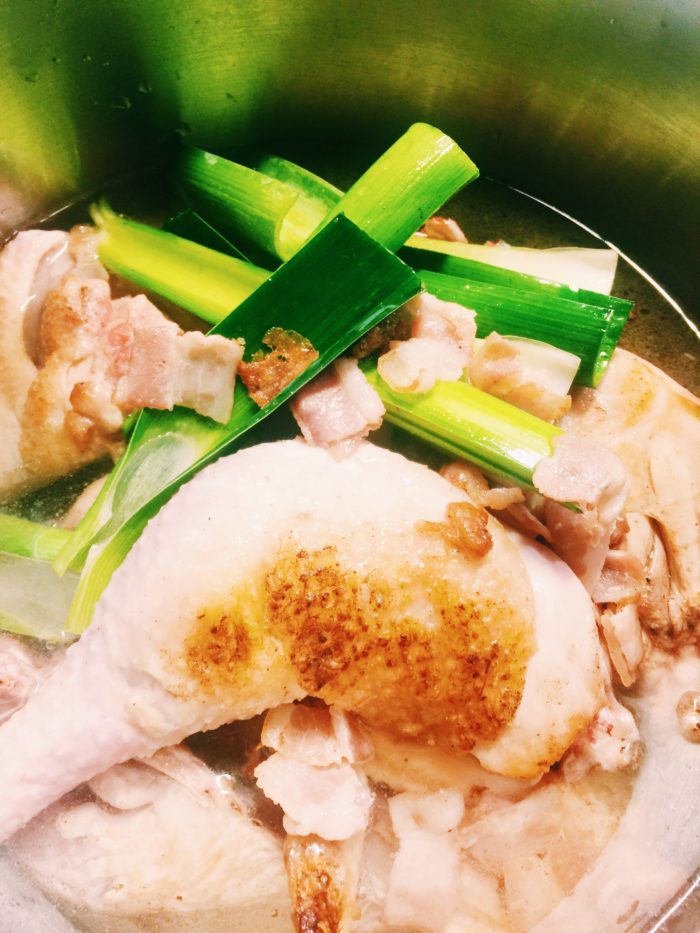
My instincts is to make a chicken stock in the same way I would for a chicken and vegetable soup. Then I would saute the white parts of the leeks, before adding back the strained broth, some cut up cooked chicken and a few sliced prunes. After consulting some other experts, thank you Mary Berry, think I am going with my instincts, but feel free to add some cooked bacon, as there is no doubt that chicken, leeks and bacon are a winning combination.
I am going to give you quantities for feeding a crowd,so am suggesting using a whole chicken, a couple of chicken portions would work too.
Cock-a-leekie Soup
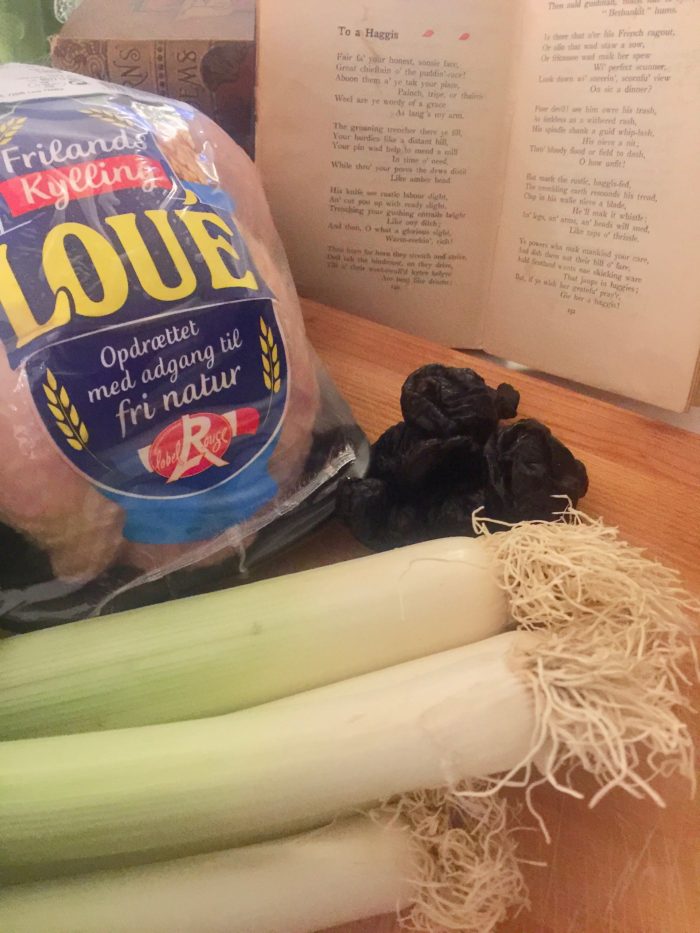
INGREDIENTS (FOR STOCK)
- 1 chicken or some pieces of chicken on the bone
- 3 leeks, trimmed green parts only, reserve the white parts for the finished soup
- 3 stalks celery, halved
- 3 carrots, halved
- few parsley stalks
Place all ingredients in a large pot and cover with water, Bring to boil and then simmer gently for two hours. Every so often skim the scum off with a large spoon.
Using a colander, strain the contents of the pot. Once the chicken has cooled slightly, remove the meat from the bones, discard the vegetables. If you leave the stock to get really cold the fat will rise to the top and can be scooped off. I generally do not remove the fat as that is what gives this home made stock so much flavor. Also I am in the ‘fat is essential’ camp, it really is not the enemy.
To finish
- 3 white parts of leeks, sliced
- chicken from cooked chicken (Depending on how many you are feeding you may have extra chicken, perfect for coronation chicken)
- handful of prunes, thinly sliced
- chicken stock cube ( I know, it’s a British thing to give a little extra body)
- little butter or oil
Method
- In a large pan, heat a little butter or oil.
- Gently sauce the sliced leeks, be careful not to allow to brown.
- Add back in the stock and a chicken stock cube.
- Just before serving add the shredded chicken and sliced prunes.
- Add salt and pepper to taste
Cranachan
Cranachan is one of the most popular desserts to serve at a Burn’s night. It combines some of Scotland’s finest ingredients oats, honey, raspberries and whiskey to give a stunning end to the meal.
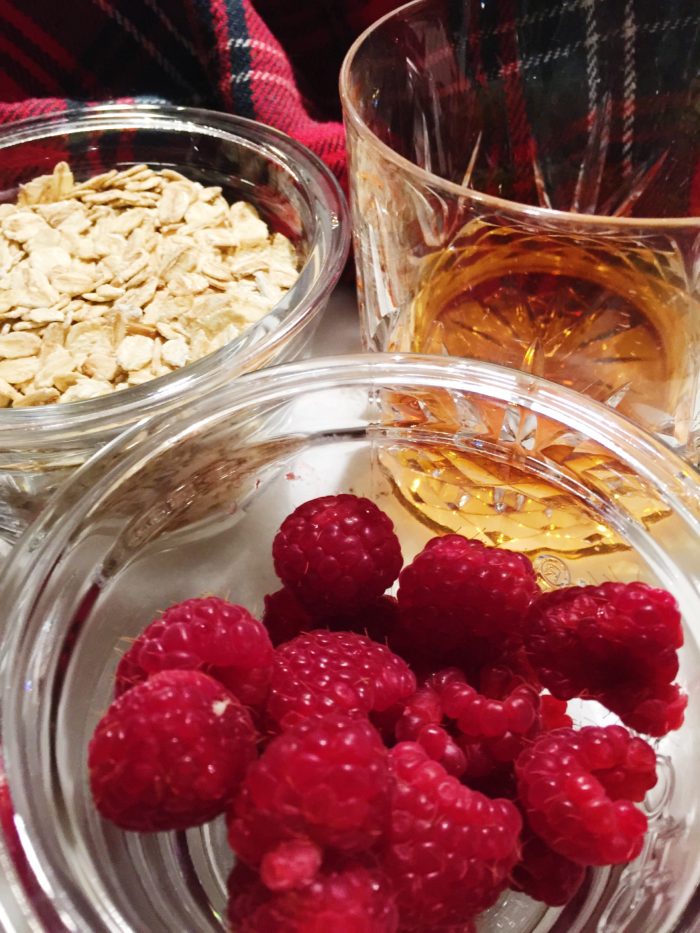
Ingredients (rough guide, adjust to taste)
2tbs oatmeal
1tbs sugar
300g rasp (or whatever size they come in)/frozen raspberries would work at a push
375ml/3/4 pint/11/2 cups heavy cream
2 tbs honey
2-3tbs whiskey
Method
Add the oats to a frying pan or skillet.
Over a medium heat lightly toast the oats to realise the nutty flavour, be careful not to burn them. Leave to one side.
Take around three quarters of the rasps and puree them. Add a little sugar to sweeten.
Whisk the cream until it is fairly firm. Add half the raspberry puree and honey and whiskey to taste. Add 3/4 of the toasted oats.
Layer the raspberry cream mixture and the raspberry puree between pretty glass dishes and top with the remaining raspberries and oats.
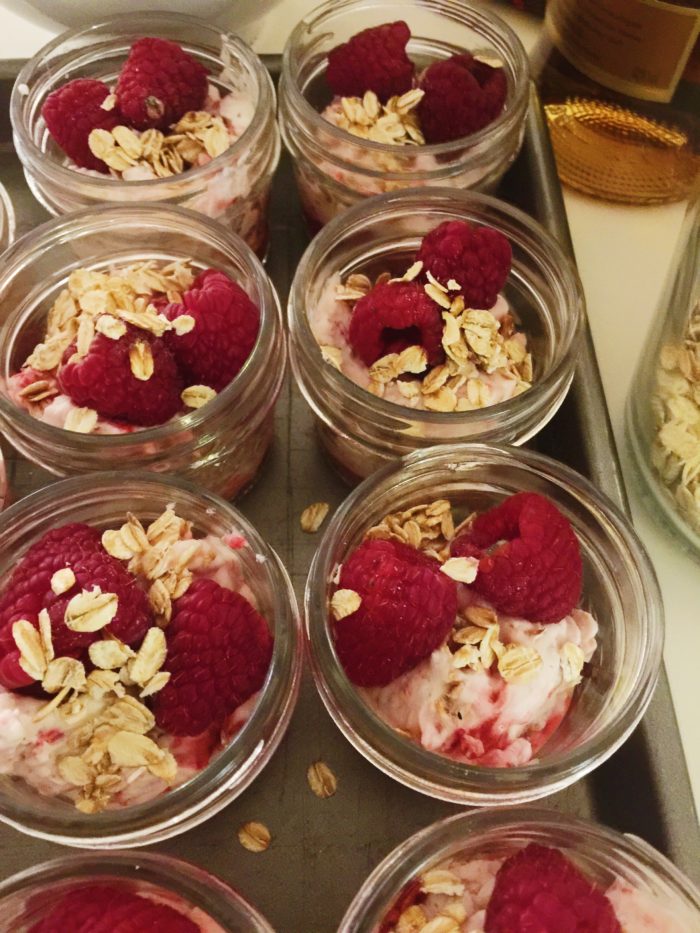
I am leaving you with Scotland’s own Susan Boyle and her beautiful rendition of ‘Auld Lang Syne’.
Reply to the toast to the Lassies
Growing up in the North East of Scotland I was literally surrounded by Burns. My father bought a pub, the St Andrews and in his infinite wisdom, and he is very wise, decided to decorate all the wall with murals of Burns poems.
There was “Willie’s Prayer”, appropriately for a pub“The Deil’s awa with the Exciseman” but the one I remember was “Tam O’Shanter”.
For those of you not too familiar with Burns, Tam O’Shanter is regarded as his finest work. In it, Rabbie sums up men, woman and marriage with a caustic wit, and draws characters we all recognize.
The story starts in a pub, where ‘droughy neighbors neighbors’ meet. Tam is there with his mates, who keep him company
When chapmen billies leave the street,
And drouthy neibors, neibors meet,
As market days are wearing late,
An’ folk begin to tak the gate;
While we sit bousing at the nappy,
And getting fou and unco happy,
We think na on the lang Scots miles,
The mosses, waters, slaps, and styles,
That lie between us and our hame,
Where sits our sulky sullen dame.
Gathering her brows like gathering storm,
Nursing her wrath to keep it warm.
And there we have it. The guys are sitting in the pub and the wife is at home getting mad. And who among us ladies do not recognize that scene from somewhere in our married lives, ‘nursing our wrath to keep it warm’ Fantastic!
And why are they mad ….because the men never listen!
‘Ah, gentle dames! it gars me greet,
To think how mony counsels sweet,
How mony lengthen’d, sage advices,
The husband frae the wife despises!’
But it gets worse. Tam is a complete idiot. He knows the only way home is past the auld haunted kirk, but yet he stays drinking with his mate, Souter Johnny,
His ancient, trusty, drouthy crony;
until it is really late. And then off he goes
And of course, as he passes the kirk he sees lights and rather than keep going, back to the bosom of his loving wife, he stops to investigate. A hideous sight awaits him, I cannot tell you the details, but still he looks and there in the middle of it all is a beautiful young wicked witch, dancing in a very short skirt. Actually it was a long shirt, a cutty sark.
It just keeps getting worse. Still Tam does not turn back, as he is mesmerized by the sight of the dancing witch. Finally, at the end of the dance, he shouts out ‘Weel done cutty sark!’. Well that’s it, the lights go out, and the chase in on.
And that was the scene we had painted across a large wall in our pub. Tam on his horse being chased by fearsome witches and warlocks and, at the head of them all, Cutty Sark.
Luckily for Tam everyone knew that the evil creatures could not pass running water. Tam and his horse Meg manage to escape, by crossing over river. Just as they reach the bridge, Cutty Sark grabs hold of the horse’s tail and pulls it off. So they are safe with only the loss of Meg’s tail, a cautionary tale so to speak.
Possibly not the best scene to have in a pub, warning the evils of drink. But maybe another way to look at it, is that you can push the boundaries, have a great time and still get away with it. Rabbie is not condoning Tam’s behavior, but neither is he condemning it. He was a man after all!
Of course, with equality a lot has changed since Burn’s time. In Denmark, it is quite possibly the woman who are out whilst the man sits at home wondering just who is going the light the candles.
Whilst researching for this speech I came across a Danish Burns website. It seems some of Rab’s descendants came to Copenhagen and brought with them some previously unpublished work. When I was at the Dubliner the other night I met up with Rasmus Burns and he shared a new poem with me, it is just a fragment, but it has been passed down from generation to generation, penned during a short trip by Rab to Copenhagen
To a …?
On Friday, they’re nae at the sink
Cos they go roaming out with Link
Where Viking bikers fill the street,
The Dolphin Fountain’s Far they meet
East to spot, if Rachel’s there
Wi that reed coat, she likes to wear
Debs, our leader, plans the walk,
Lots of lassies, lots of talk
Roon the lakes and past the tower,
Done in a wee bit o’r an hour,
Except when Vicki takes up the post,
Then a’body gets a wee bit lost,
But they spy a glorious sight,
A highland hame, with Carlsberg light,
Nae thoughts of work, or husbands supper,
A spot of lunch and then a cuppa
On train and bike, then wynd they hame
Next week, they’ll meet and do the same.
Rabbie was a womanizer, by all accounts, a very cute one. He had the gift of the gab and the children by numerous woman to prove it.
But that is Because Burns was also all too aware of the fragility of life and the need to ‘carpe diem’. Again, from Tam O’Shanter we have
‘But pleasures are like poppies spread,
You seize the flower, its bloom is shed;
Or like the snow falls in the river,
A moment white–then melts forever;’
He also held out hope for mankind, and for men. Burns imagines a future world in which all people will live as brothers, in mutual trust and respect. Like many Scots, he was a wee bit of a socialist.
But most of all he was a romantic He gave us love poems such as ‘My love is like a red, red rose’. For some reason in our house we associate love with yellow roses and that is what Alan gives me every year, most years, well some years, on our anniversary.
Burns also gave us the magnificent lines
‘But to see her is to love her, love but her and love forever’.
Sadly. I do think it was his future wife he was talking about!
He finally married the love of his life and they were still together when he died at the very early age of 37.
We, as Scots, are privileged to share heritage with Robert Burns. We are also incredibly lucky to be here tonight, in the company of international friends. But most of all we are lucky to be here with our men, flawed as they are, but we love them.
Ladies raise your glasses
To the Laddies!



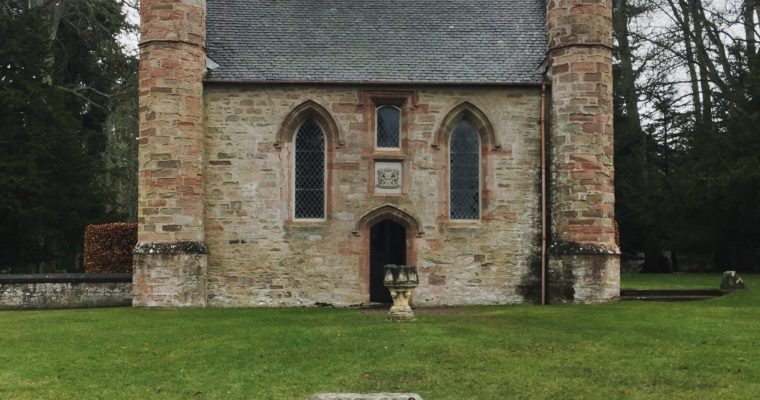
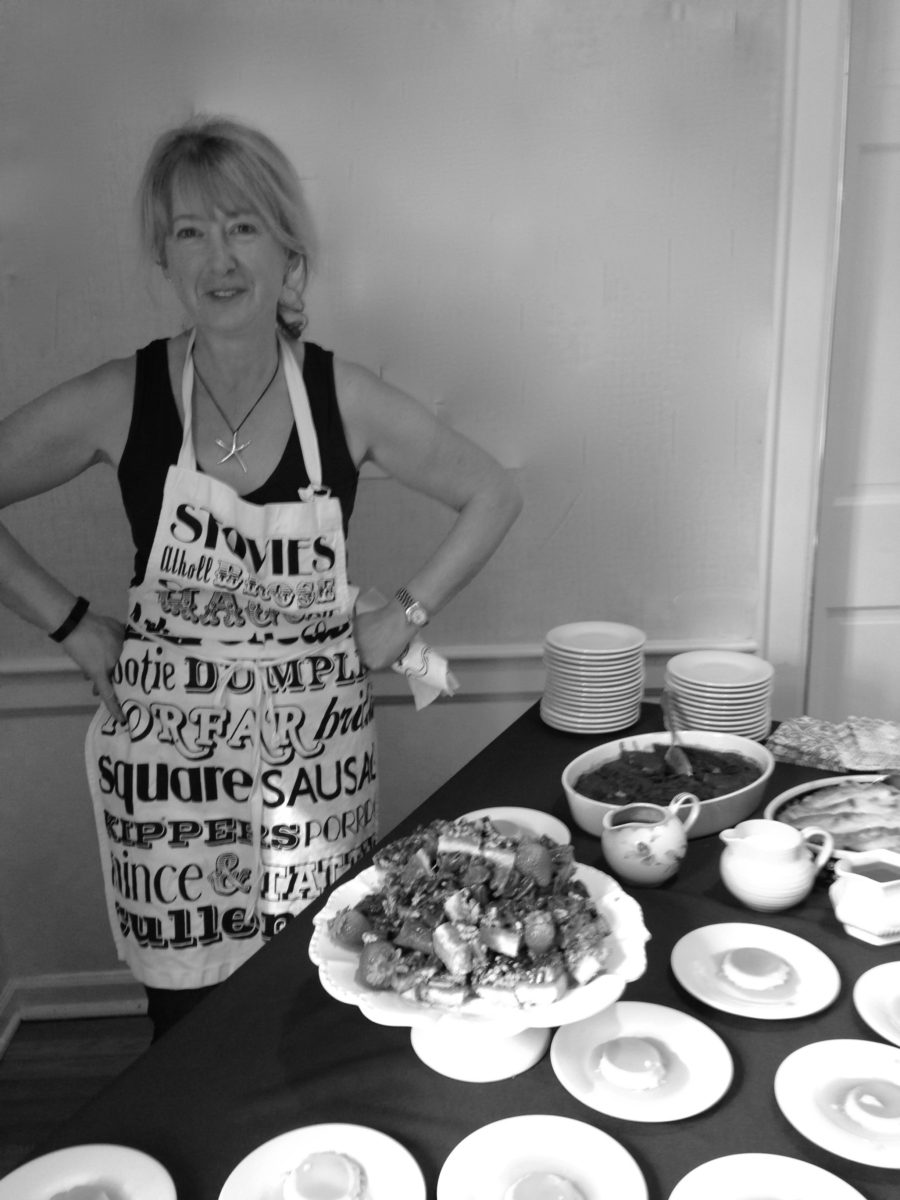 That's me in the corner
That's me in the corner



